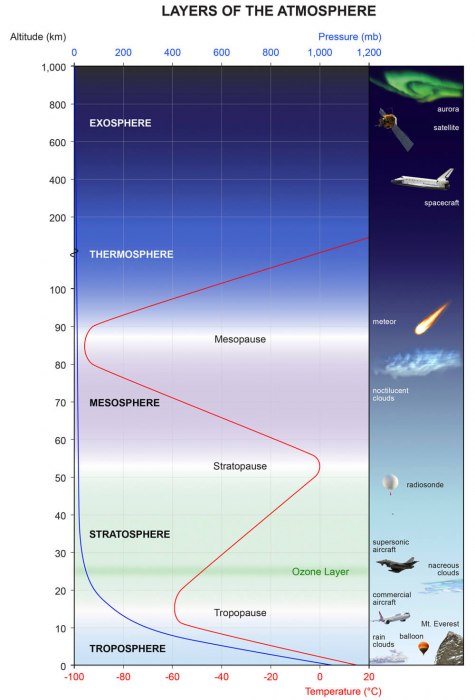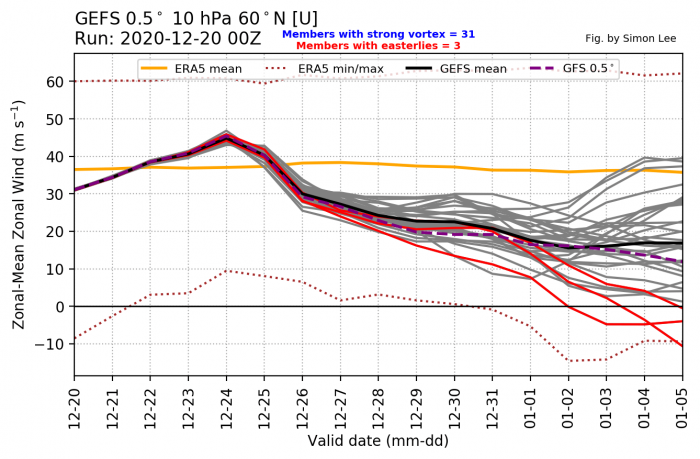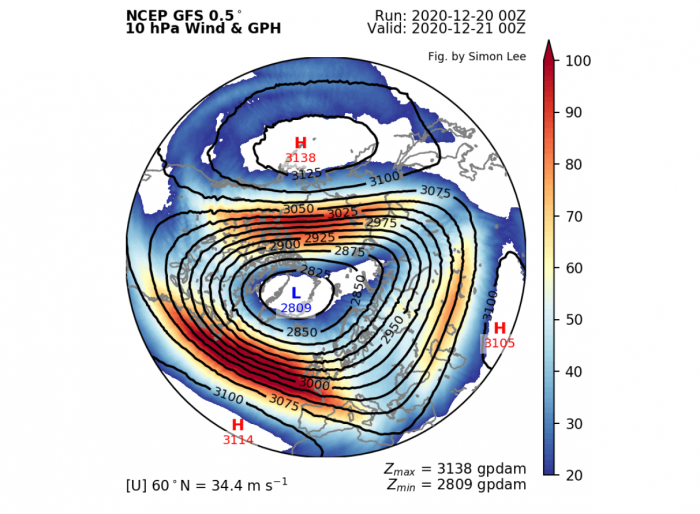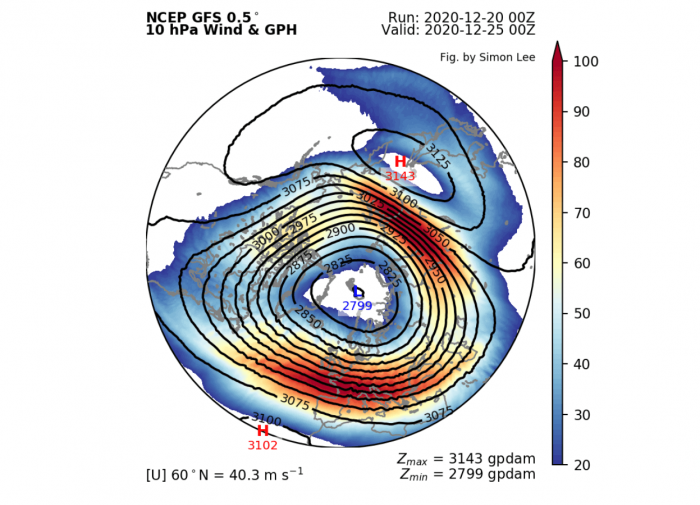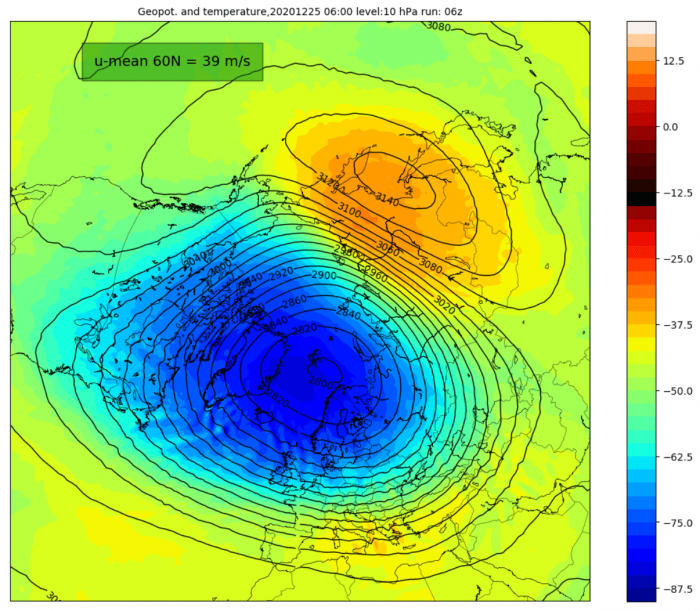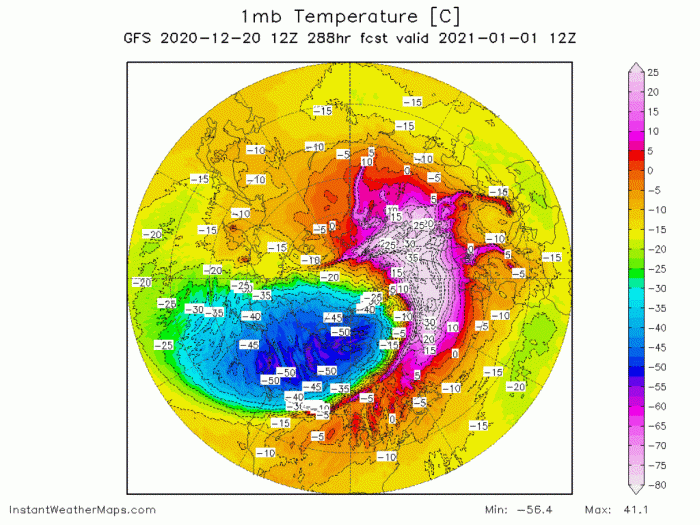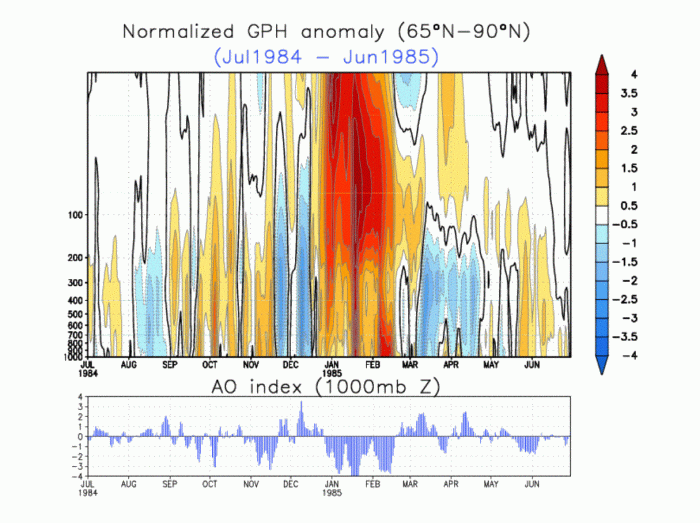A warming event high up in the Stratosphere is looking likely to unfold at the start of the new year 2021. Stratospheric warming events in winter, are very important, as they can change the course of winter weather development and affect global circulation.
The “main actor” in these powerful events, is of course the Polar Vortex. It connects the bottom of the atmosphere (our weather) with the stratosphere above it. A strong exchange of energy between these two layers can shake the very foundations of the weather development across the Northern Hemisphere.
WHAT IS THE POLAR VORTEX?
The atmosphere above us has many different layers. All of the clouds and the weather that we feel are found in the lowest part of the atmosphere called the troposphere. It reaches up to around 8 km (5 miles) altitude over the polar regions and up to around 14-16 km (9-10 miles) altitude over the tropics.
Above it, there is a different layer called the stratosphere. This layer is around 30 km thick and is very dry. Pressure values on top of the stratosphere (~52km altitude) are 1000-times lower than on the ground! Unlike in the troposphere, the temperature in the stratosphere increases with altitude. We can see the layers of the atmosphere on the image below, with the stratosphere in green hues, and the troposphere in blue at the bottom. The red line nicely shows the temperature progression with height above Earth.
Every year as we head into autumn, the north pole starts to cool. The solar input to the north pole decreases as the angle of incoming solar rays lowers. Eventually, the solar angle is so low, that no direct Sun rays can reach the north pole. That is known as the “polar night” when the Sun stays permanently below the horizon for a certain period.
The image below shows the temperature progression graph over a year, in the middle stratosphere (10hpa / ~30km altitude). We can see the seasonal temperature cycle, which corresponds to the length-of-day and the angle of sunlight. The temperature starts to drop as soon as the days are getting shorter (Late June-July) and starts slowly rising again as days are getting longer again (Late December-January).
The reduction in temperature also coincides with a gradual pressure drop over the north pole. In the stratosphere, the process is the same. Due to the temperature changes over the pole and the increasing temperature difference with the warmer air further south and the effects of earth spinning, a low-pressure area starts to develop across the stratosphere. It is almost like a very large cyclone, covering the whole north pole, down to the mid-latitudes.
The polar vortex is not found only in the stratosphere, but it reaches all the way down to the ground. We can see in the example image below for late October, how the polar vortex looks at different altitudes. Essentially it is one large cyclonic circulation area. The lower we go, the more dynamic or “disrupt” it is. That is because of the effects of terrain, like mountains on the circulation and the weather fronts.
A DISTURBANCE IN THE WIND FORCE
Going straight to the point, we present you with the high-resolution animation of the Sudden Stratospheric Warming event (SSW) forecast over the north pole in early January 2021. It shows the 10mb level (~30km altitude), revealing a strong warming wave developing from the Asian sector. It compresses the cold polar vortex, greatly reducing its power. We will talk below about how exactly this is set to occur and what it can mean for winter weather down the line.
As a general reference, we usually look at the polar vortex in the stratosphere at the 10mb/hPa level. That is around 28-32km (17-20 miles) altitude. This is considered to be around the middle stratosphere, and thus a good representation of the general dynamics in the stratosphere.
Looking at the current state of the polar vortex at the 10mb level, we can see it as a large cyclonic area over the Northern Hemisphere, centered over Greenland. It is very cold in its core, with temperatures reaching below -80°C.
Towards the Pacific side, we can see its arch-nemesis, the stratospheric high, sometimes also called the stratospheric anti-vortex. This is called a wave-1 pattern, as there is only 1 high-pressure ara affecting the polar vortex. The graphic is by weatheriscool.com.
The strength of the polar vortex is most often measured by the power of the winds inside it. Usually, this is done is by measuring the zonal (west to east) wind speed around the polar circle (60°N latitude) at the 10mb level.
An SSW event is officially declared when the zonal winds around the polar circle are zero or negative. That means that the stratospheric jet stream is reversed (from westerly to easterly), and the stratospheric high (anti-vortex) has taken over. It usually means a collapse of the polar vortex, which can have a cascading effect downward towards the surface, impacting the winter weather development.
As an example, we have the polar vortex wind forecast below, for the polar circle at the 10mb level. We can see that the polar vortex is currently quite strong, and is set to get even stronger in the coming days. It is set to weaken towards the new year, with each new calculation increasing the likelihood for a proper Stratospheric warming event.
On the image below we can nicely see the current polar vortex (L) over Greenland and the polar “anti-vortex” (H) over the North Pacific. Colors show the wind speed.
But as we have seen on the graph above, the forecast indicates the polar vortex gets stronger towards Christmas. Or does it?
The wind speed increase in the polar vortex does not always mean that it is getting stronger per se.
As we can see from the images below, the increase in wind speed is actually because a new polar high is developing from the Asian sector. It is a new wave-1 pattern, pushing strongly towards the polar vortex and increasing the pressure difference between these two powerful systems, and thus the wind speed around the polar circle.
So far, we were looking at the wind speeds at one level in the stratosphere. But now we are going to look at the entire layer from the surface up to the top of the stratosphere. The image below is very easy to read. It just shows the strength of the zonal (westerly) winds over time from the surface up to 50km altitude.
There are some events outlined in the image below (by weatheriscool.com). The black box shows the wind speed power-up phase in the coming days, as we just discussed above. The blue box outlines some events near the surface, which we will discuss next.
We can see in the previous image, that in the period between 27th to 29th December, there is a weakening in the circulation in the bottom layers. This is actually related to pressure patterns in the troposphere, which we can see on the regular maps.
Below we have the 500mb anomaly pattern for this post-Christmas period, which shows a very significant high-pressure system over North Atlantic and Greenland. It is merging with other high-pressure areas across the North Pole, creating a great disturbance in the polar weather circulation.
These high-pressure weather “waves” and disturbances near the surface play a pivotal role when it comes to the stratosphere. Such strong events can deflect a lot of energy/momentum upwards into the stratosphere, promoting pressure waves and warm waves.
The lowest levels of the stratosphere are usually found at the 100mb level (15km altitude). The graphic below from Simon Lee shows the power status of the polar vortex at the lowest levels of the stratosphere. We can see the early strong phase (blue bars). Around the post-Christmas period, the weather pattern changes we discussed above are seen severely weakening the polar vortex in the very bottom levels of the stratosphere. Most of the ensemble members show the weakening phase coinciding with the high-pressure disturbances.
Looking back at the earlier graphic, we now know what the Blue box is. The red arrows show how the lower zonal wind speed values are moving upwards over time. It is nicely seen how the green color is moving further up into the stratosphere.
This is a pretty obvious upward propagation signal, which tends to release a lot of energy as it reaches the top of the stratosphere. The disturbance and the wave energy is then released upon the top and middle stratosphere, weakening the polar vortex and finalizing in an SSW event, in the red box. It is indicated by the negative (reversed) wind direction in the upper and middle stratosphere.
SUDDEN STRATOSPHERIC WARMING SEQUENCE
We now know that a strong disturbance will affect the stratosphere. But how exactly will the SSW develop? We will look at the sequence in the latest GFS model forecast on December 20th, 12Z run.
This is the most aggressive forecast to date this season, showing a very powerful SSW event to unfold. It is tho likely to adjust significantly with fresh calculations in the future, but it will be a great example of a strong stratospheric warming sequence.
At the same time when the wave disturbance from below will already start moving upwards, the polar vortex will be under attack from an advancing pressure wave. A new temperature wave will also start to engulf the outer regions of the polar vortex.
By the end of the year, the warming wave will intensify, along with the strong high-pressure system from the Pacific-Asian sector. This will further compress the polar vortex, causing it to “leak” energy.
To show just how powerful this warming wave is forecast, we can look at the top of the stratosphere at the 1mb level (~50km altitude). The maximum temperatures in the warming wave are reaching up to +40°C (104°F)!
Going into the new year, the polar vortex is significantly weakened at this point, with core temperatures just holding around -70°C, which is quite warmer than normal. We can see in the corner that the zonal wind at the polar circle is 0m/s, which means this would be officially classified as a major stratospheric warming event.
A few days later, the polar vortex is effectively split into two parts, from a double pressure wave compress. The main part moves over the Euro-Atlantic sector, with a smaller lobe over western North America. It essentially shows the complete dominance of the polar “anti-vortex” over the North Pole, and the polar vortex defeated.
Further down at the 50mb level (~20km altitude), we can see a similar situation, tho less intense, as it takes some time for the process to propagate downwards. The polar vortex is pretty much unrecognizable, heavily disrupted into 3 separate cores. One is over North America, one over Northern Europe, and one over the East Asian sector.
WEATHER IN THE POST-STRATOSPHERIC WARMING WORLD
Of course, we all want to know “what does this mean for our weather?” and “how much snow will I get from this?”. These are very good questions, and it takes some time to answer them. We need to see how exactly the SSW event will play out (if at all at this strength) before we can simulate proper weather results.
But, a collapsed vortex always greatly increases the chances for winter weather towards Europe and the Continental United States. A lot depends on how the existing pressure pattern looks, while the effects from the stratosphere come crashing down from above.
In some cases, the effects can be partially “deflected” and we don’t feel much of a change in our daily weather. But in most cases, the effects can have a major influence on the distribution of weather systems across the hemisphere.
The graphical example below shows the average temperature anomaly 0-30 days after a major stratospheric warming event. We can see the main cooling effects are across Eurasia and the eastern United States. This is an average picture, combined from all the known major warming events in the past 40 years. So the actual results can vary from event to event.
Looking at snowfall anomalies, we can see a tendency toward an increased amount of snowfall in the eastern United States and Europe.
A very strong and famous SSW event unfolded at a similar time, on the verge of the new year in winter 1984/1985. Below we have the image which shows the temperature anomalies 0-30 days after this SSW event, warming the polar region and unleashing cold air towards Europe and the United States.
The image below from NOAA shows the pressure progression during the winter of 1984/1985. We can see high-pressure anomalies in the upper layers, connecting down to the surface and sending the Arctic Oscillation into a negative mode (bottom graph). Negative Arctic Oscillation indicates a disrupted polar circulation, spilling the cold air out of the Arctic and down towards the mid-latitudes.
Such cold weather is not to happen with every SSW event, but history can show us what is possible. Winter 1984/1985 is known to be quite cold, but not a lot of people know that a strong SSW event played a major role in its weather development.
We will keep you updated as fresh data is available, and more reliable forecasts are released. We will also look at possible weather development scenarios, following the SSW event when/if it materializes.
See also:
DON’T MISS THE GREAT CONJUNCTION OF JUPITER AND SATURN TONIGHT:
Thinking of a nice Christmas gift for your friends, family or someone special to you? Weather calendar could be the perfect gift for them – see below:
